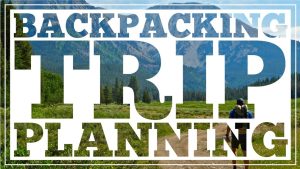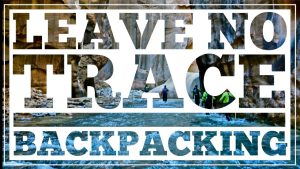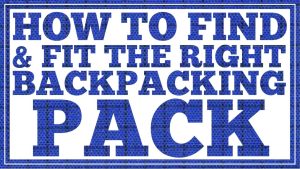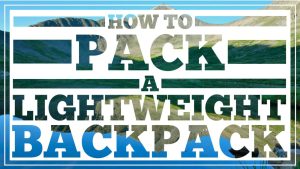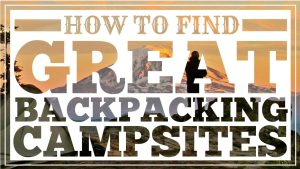Ep. 7 – Navigation #2 – Map, Compass & GPS
We independently test everything we recommend.
Buying through links on our site supports our work.
Backpacking Navigation – Map, Compass & GPS
No matter how simple your route may be, understanding how to use basic navigation equipment is a crucial skill for any backpacking adventure. A map and compass can keep you from getting lost or help you find your way again, and they’ll allow you to explore rarely traveled backcountry areas safely.
Any expert will tell you that a map and compass are essential items for any backcountry trip. But they won’t do any good if you don’t know how to use them. Becoming a navigation expert will take years of practice and experience in the field, but learning the basics is very simple.
Make sure to hone your skills before you attempt any backpacking trips that require difficult navigation. Never put yourself in an unsafe situation by being unprepared. If you need to brush up on your skills or want learn some advanced techniques, consider signing up for an orienteering course in your area.
Orienteering courses can be a lot of fun and they will give you great practice in a safe environment.
Topo Maps – Contour Lines
The first navigation tool you need to understand is your map. Maps come in all shapes and sizes and they will provide a detailed image of the land you’ll be traveling through. Guidebooks and online resources often have simplified maps that show trails over basic terrain. Simple maps can be a great help with trip planning but they’re not as useful for on-trail navigation.
A topographical map is the tool that you’ll need to navigate in the wilderness. Topo maps are much more accurate, detailed, and they provide an elevation profile of the area. Understanding contour lines is really the key to understanding topographical maps. Contour lines are the small squiggly lines that cover the entire map.
A single contour line marks a given elevation on the map. For example, a 5,000 foot contour line will touch every point on the map where the elevation is 5,000 feet. If you travel up or down in elevation from the 5,000 ft line you’ll hit a new contour line, which will denote a different elevation.
Contour lines never intersect. When contour lines are close together, it denotes very steep changes in elevation, like a steep cliff. When they are far apart, it denotes more gradual or gentle changes in elevation, like a valley floor or a field.
Topographical maps will help you to orient yourself by showing the terrain features of the area. You’ll see peaks, valleys, rivers, cliffs, and other prominent features in the landscape. When you understand the features in the landscape, you’ll be able to understand your trip better and plan your route from one point to the next.
Good topographical maps may also have colors and shades to help you orientate yourself. For example, heavy vegetation areas may be shaded in green while areas above tree line may be left white. There also might be shading to help you distinguish the slopes of north and south facing ridges and valleys.
All topographical maps will also have a scale to help you understand the size of the terrain and a legend to help you understand the symbols on the map. Good backpacking maps will list hiking distances on well-defined trails, but that isn’t always the case, so make sure to look for trail mileage.
Understanding Declination
Declination is another measurement that will be listed on a topographical map. Declination is a concept that can be somewhat confusing, but it’s easy to understand once you know the principle behind it.
Maps are oriented with lines pointing towards true north, the North Pole. But your compass needle actually points towards magnetic north, which is slightly different than true north. The degree to which they are different depends on where you are on the earth and declination is simply a correction that will account for the difference between your map and compass.
Sometimes the declination is so small, especially over short distances, that it won’t really matter. For maximum accuracy, especially when hiking long distances, it’s important to correct for declination.
A simple saying that will help those of us in North America to remember is: Declination east, compass least. Declination west, compass best. Meaning, if the declination on your map is to the east, you will subtract degrees from your bearing, declination east, compass least. And vise versa for west declinations.
Using A Compass
Your compass is the tool that you will use with your topographical map to help you locate yourself and plan a route without using any trails to get to a destination. Even if you plan on traveling on-trail for your entire trip, knowing how to use a compass can come in very handy.
For example, you might loose the trail and need to locate your position on the map or determine the best direction to hike back out to a road. The trail could be covered in snow near the top of a ridge and you need to know witch way to travel to meet back up with it on the other side. Or maybe you just want to explore an off-trail area, but you need to be sure of which direction to go and keep yourself from getting lost lost.
To learn how to use a compass, let’s start out by taking a look at the parts of the compass.
Parts of a compass:
- Needle – always points to magnetic north
- Dial or bezel – is that part that spins
- Orienting lines – are on the back of the dial, they spin when the dial spins
- Degree or index lines – are the 360 marks around the dial
- Direction of travel arrow – is the direction you’ll walk after you take your reading
Taking a compass bearing is pretty straightforward. Lets say for example that our trail has been covered in snow, and we don’t know which way to travel. Here’s what we’d do:
Taking a Compass Bearing
- Locate where we are on the map
- Then, we would line the edge of our compass up with the direction we want to travel being as precise as possible.
- Next, we turn the dial on our compass until north on the bezel lines up with north on the map and the orienting lines on the compass line up with the north south lines on the map.
- Once we have it all lined up and we’ve double checked our route, we remove the compass from the map, correct for declination if necessary.
- Hold the compass away from our body, and turn our body until the compass’s needle lines up with the orienting arrow pointing north. Put the mouse in the house.
- Now, the direction of travel arrow is pointing towards our destination. If we’re in a large open area, you can pick a defined point on the horizon and walk directly towards it. Or if we’re in a forest, we can pick an object like a tree, walk to it, then hold up our compass and pick another point to walk to.
Traveling by Compass
If you’re traveling by compass for long distances, it’s important to get very accurate readings and to use landmark clues like rivers, peaks, roads, and ridges to make sure you hit your mark. A 1 degree mistake on a compass reading can put you off your mark by over 100 feet after you’ve traveled a distance of one mile. So planning a smart route is key to succeeding over long distances.
Don’t shoot for a small target that is many miles away, because you’re likely to miss your target. Instead, use the terrain to your advantage and pick shorter goals to make sure you stay on track.
Line Location by Compass
Another common use for a compass is to find your location on the map using your compass as a guide. This is called line location and triangulation.
In order to use your compass for triangulation, you’ll need to find at least two or three prominent features in the landscape that are also on your map. It’s best if the features are somewhat spread out, and not right next to each other. To triangulate your position, you’re going to use a similar technique that we just used for taking a bearing, but we’re going to reverse the order.
- Take your compass and point it at the first prominent feature that you know is on your map.
- Then, with the direction of travel arrow pointed at that object, twist the dial to line up the needle with north on the dial.
- Now, take your compass and place it on your map, lining the orientation lines of the dial up with the north south lines of the map.
- Slide the compass up and down so that the object you were measuring is lined up with the edge of the compass.
- Now use a pencil to draw a line on the map. Because of your calculation, you know that you must be somewhere along that line.
- If you repeat the same steps two or three more times using different objects, your exact location will be where the lines intersect.
GPS Devices
Another very helpful tool for navigation is a GPS device. If you’re going on a trip that will require lots of off trail navigation, a GPS device can be a very useful tool to have.
If you get lost, a GPS unit will give you your exact coordinates, which you can use with your map to pinpoint exactly where you are. GPS units can also be used to store waypoints, which are saved locations that you’ve been to, like the trailhead or your vehicle.
You can input one or multiple coordinates into a GPS unit from a map or guidebook. Then, you can use the GPS to route you from one coordinate input to the next. Most GPS units will only give you straight line directions though, so you’ll still need a map to see what the terrain looks like, and to see if there are any obstacles in the way, like cliffs, steep valleys, or large rivers.
A GPS unit can also track your hike as you go. It will take readings to put together a loose route of where you’ve been. Most units can tell you your mileage, speed, and elevation gain.
GPS units do have their shortfalls though, so always be careful when you take technology out on the trail. GPS units are powered by batteries, and batteries will run down over time. Don’t get caught without the proper knowledge and tools because you ran out of batteries in the woods.
Also, GPS units can loose their signal when in dense brush or in deep valleys. You usually need a clear view of the sky and 4 satellites to be able to pinpoint your location. Even if you do have a GPS unit, always bring a map of the area and compass as a backup.
Wrap Up
Now that you know the basics of navigation, you’ll feel much more comfortable finding your way on the trail. Make sure to practice your skills and consider taking an orienteering class to master wilderness navigation.
If you enjoyed this video and article, let me know by clicking the little heart below. If you have any questions or comments, leave a message and I’ll respond as soon as possible. Thanks!
MORE EPISODES IN THIS SERIES
View all